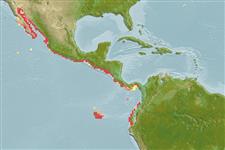Classification / Names
Common names from other countries
Main reference
Size / Weight / Age
Max length : 22.0 cm TL male/unsexed; (Ref. 96339); common length : 12.0 cm SL male/unsexed; (Ref. 9298); max. reported age: 3 years (Ref. 905)
Length at first maturity
Lm 12.9, range 12 - ? cm
Environment
Marine; brackish; pelagic-neritic; non-migratory; depth range 0 - 32 m (Ref. 96339)
Climate / Range
Subtropical, preferred 27°C (Ref. 107945); 32°N - 4°S, 115°W - 78°W (Ref. 54323)
Distribution
Eastern Pacific: southwestern coast of Baja California, Mexico and from the Gulf of California to northern Peru (up to the Bay of Sechura). Apparently reaching Los Angeles, USA, but these are perhaps releases from tuna boats.
Countries | FAO areas | Ecosystems | Occurrences | Introductions
Short description
Dorsal
spines
(total): 0;
Anal
spines: 0;
Anal
soft rays: 17 - 24. Head large and deep. Snout short and pointed, about 2/3 eye diameter; maxilla moderate, tip blunt, just failing to reach lower jaw articulation; lower gill rakers fine and numerous, increasing in large fishes; no gill rakers on posterior face of third epibranchial. Branchiostegal rays 8, long and slender; branchiostegal membrane broad. Silver stripe disappearing at about 8-10 cm SL.
IUCN Red List Status (Ref. 115185)
Threat to humans
Harmless
Human uses
Fisheries: highly commercial; bait: usually
More information
ReferencesAquacultureAquaculture profileStrainsGeneticsAllele frequenciesHeritabilityDiseasesProcessingMass conversion
Tools
Special reports
Download XML
Internet sources
Estimates of some properties based on models
Phylogenetic diversity index
PD50 = 0.7500 many relatives (e.g. carps) 0.5 - 2.0 few relatives (e.g. lungfishes)
Trophic Level
2.5 ±0.21 se; Based on food items.
Resilience
High, minimum population doubling time less than 15 months (K=0.9-2.6; tm=1; tmax=4)
Vulnerability
Low vulnerability (12 of 100)
Price category
